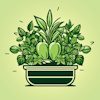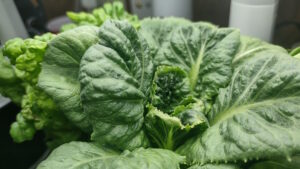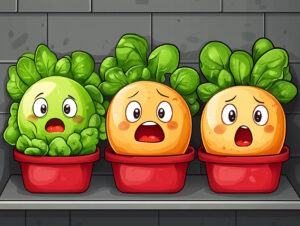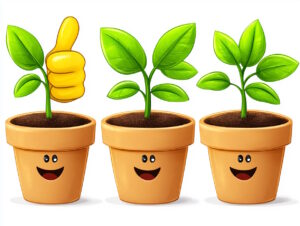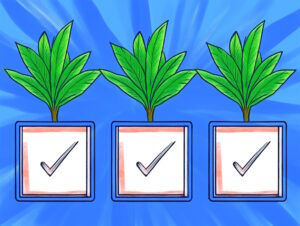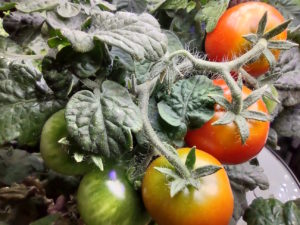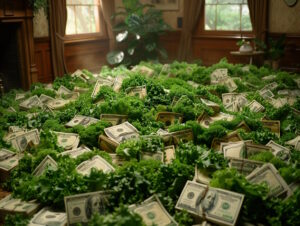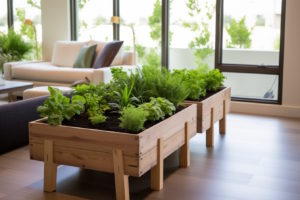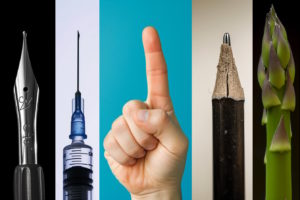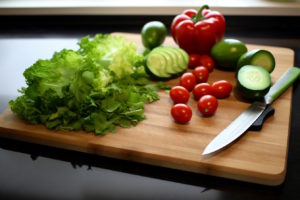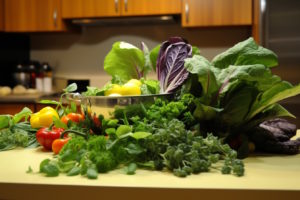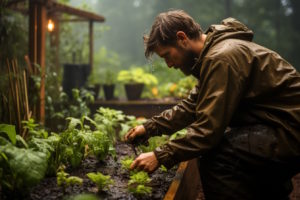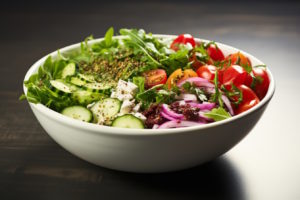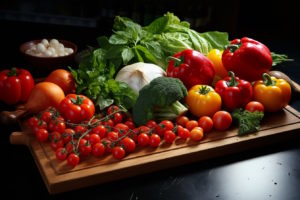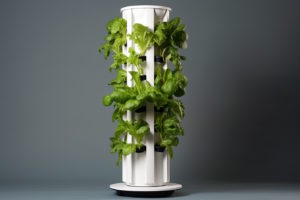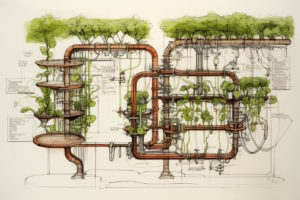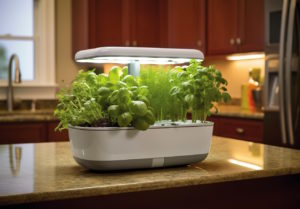A Raised Bed Garden Indoors? Bring It On!
Your indoor raised bed is called a Self-Watering Container System. You’re going to like it!
The Self-Watering Container System is a self-contained soil-based garden you can set on the floor in a corner. The automatic lighting and wicking action of the large water reservoir reduce the time you spend tending to your garden. The superior potting mix and fertilizer ensure a healthy crop. It’s gardening; it’s just indoors!
This article begins with a review of the Raised Bed System, from which the Self-Watering Container System derives. If you don’t garden outdoors, or just want to get to the actual indoor-gardening stuff, you can skip this section. However, if you do skip ahead, I do recommend you back up just a bit to read the section on Square Foot Gardening.
As you read this article, you’ll see indoor gardening from a whole new perspective. Rest assured, the indoor garden bed is possible, and actually quite easy to assemble. You’ll find out how, right here.
Table of Contents
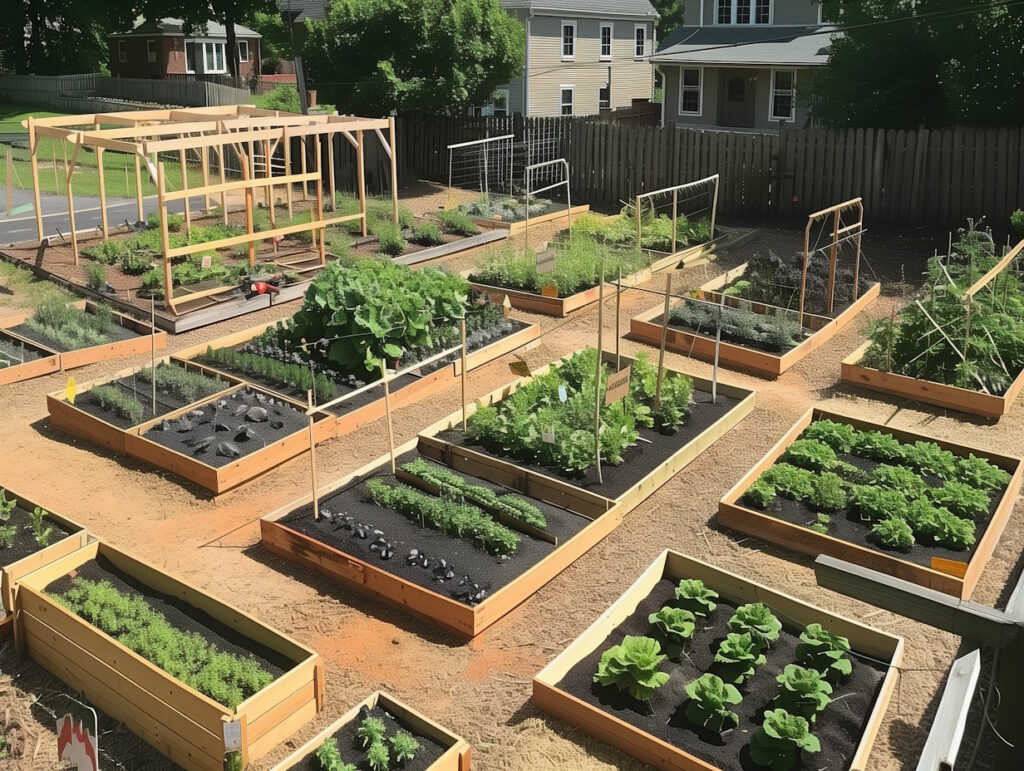
What Is a Raised Bed Garden?
A raised bed is an outdoor gardening blend of technologies and techniques that improve on the centuries-old system of plowing rows in dirt. Raised bed gardening is well-suited for backyard gardeners. Raised bed gardens are low volume, highly productive gardens.
The raised bed frame is a permanent outdoor container. A typical raised bed frame holds a soil-substitute mixture, additives, and fertilizer, and may be outfitted with a drip irrigation system on a timer. Raised beds are often associated with Square Foot Gardening techniques.
Common dimensions of a raised bed frame are two foot wide by two foot long (2′ x 2′) up to four foot wide by eight foot long (4′ x 8′), and a raised bed is typically six (6) to twenty-four (24) inches tall. But you can build one in whatever size suits you. Some are even U-shaped so you can sit in one place and reach much of your garden. Fancy!
The raised bed is open to the elements, not enclosed like a greenhouse. Rainwater augments any manual watering routine. A raised bed can be enclosed to extend the growing season and keep out bugs.
This 3′ x 6′ x 11″ cedar raised bed manufactured in Maine [affiliate link] provides a good example of a wooden backyard raised bed frame. A comparably sized galvanized metal frame raised bed like this model from Land Guard [affiliate link] costs less than most cedar frames.
Pre-built frames range widely in dimensions, cost, and durability. The companion article, Is Indoor Gardening Expensive?, investigates the cost of gardening indoors versus gardening outdoors in a raised bed.
A raised bed frame won’t work for an in-home garden. When you look at the frames mentioned above or other raised bed frames, you’ll see they don’t have a bottom or floor. You place these frames on level ground, which acts as the floor. Once filled with soil, their positions are fixed. For an indoors garden bed, you need a container, which has a floor and can be relocated.
The Raised Bed System
- A raised bed frame
- A weed barrier
- Some mixture of peat moss, compost, vermiculite, perlite, and other soil-substitutes
- Soil additives
- Drip irrigation system on a timer
- Fertilizer
- Square Foot Gardening techniques
Details of the Raised Bed System
The raised bed frame isolates the garden from ground plants. Some people spread mulch or pebbles around their raised beds to keep the lawn or weeds from encroaching on the raised bed. (Remember the raised bed frame has no floor to prevent lawn plants from growing up from the ground.)
The soil-substitute mixture provides the plant a grow media superior to dirt. It retains water and resists being compressed. (Don’t stand or walk inside your raised bed to avoid compressing the soil.) A soil-substitute mixture for raised beds can be a blend of equal parts peat moss, vermiculite, and compost. [affiliate links]
With a traditional garden, you’d begin by removing any unwanted vegetation. The raised bed starts your garden off without competition from weeds, the weed barrier [affiliate link] helps prevent growth of weeds, and removing plants that do trespass is simple.
Drip irrigation applies water to the plant directly at a measured pace to ensure maximum effectiveness. A drip irrigation system [affiliate link] saves water versus broadcasting water of a wide surface area.
Fertilizer and soil additives ensure the plants get the proper nutrients. The soil substitute provides a means to anchor plants’ roots but cannot supply the nutrition necessary for your plants to thrive.
And, finally, by applying the Square Foot Gardening techniques, you maximize your yield in your garden. Square Foot Gardening is a gardening technique that revolutionized backyard gardening by promoting growing plants in one-square-foot grids rather than in rows. You can learn about Square Foot Gardening in Mel Bartholomew’s superb book, All New Square Foot Gardening [affiliate link].
To reiterate, a Raised Bed System provides plants a nutrient-rich growth environment, a steady and plentiful water supply, and proper spacing. By following the Raised Bed System, you greatly improve your chances of a plentiful outdoor harvest.
Raised Bed System Shortcomings
While the Raised Bed System crushes the ancient tradition of plowing rows in dirt, the Raised Bed System has its limitations.
Raised beds don’t stop bugs, deer, or other critters from eating your plants. You’re responsible for deploying countermeasures to protect your plants. Chemicals, netting, and fencing keep thieving animals at bay. You need to stay on top of this for the entire lifespan of your garden.
Raised beds don’t deflect hailstones or shield plants from the scorching sun or keep plants warm enough to survive a late frost. Weather, in short, can be your enemy. A single hail storm can end your entire gardening season. Maybe the spring is extra rainy, proving it’s possible to have too much of a good thing.
Raised bed frames need annual maintenance. The weather and bugs aren’t only attacking your garden. Your raised bed frame itself is under attack. Some kits consist of metal walls, which come with their own failings (rust). All construction materials have their pluses and minuses. Suffice it to say, raised beds are far from maintenance-free.
The Genius of Square Foot Gardening
Square Foot Gardening takes a raised bed to a whole new level. A couple new levels. It’s genius. You can grow more food in less space using fewer resources in a raised bed versus tradition row-gardening techniques by employing Square Foot Gardening.
Square Foot Gardening involves replacing dirt with a mixture of peat moss, compost, vermiculite, and/or perlite and other ingredients. Since you grow your plants in a bed raised above ground level, you control what you put into the box. So use a quality growing mixture and fertilizer.
You then plant seeds by the square foot rather than in rows like in the ground. Read the back of a seed packet and you’re told to plant seeds 3 inches apart but in rows spaced 12 inches apart. Why? Do the plants only grow outward on the X axis but not the Y axis? Do you need to drive your tractor down the rows? For a walking path, you’re sacrificing a lot of real estate in your garden.
In Square Foot Gardening, you plant a grid of seeds inside a one-foot square section of your raised bed. In one square foot, you can plant 9 green bean seeds. Or 16 radish seeds.
Larger plants, like tomatoes, require 4 one-foot squares per plant. But you can cheat and grow other plants underneath and before. Start a tomato plant in the center of a 2×2 grid of one-foot squares, and plant quick-growing radishes in those same squares.
Square Foot Gardening really is far superior to row-gardening for the typical backyard gardener.
If you have an outdoor garden, you owe it to yourself to learn and follow the Square Foot Gardening techniques as laid out in the extremely popular book on the subject. These techniques apply even if you’re growing food in a bucket or a bag.
Or indoors.

The Self-Watering Container System: A Raised Bed Garden Indoors
You’ve been introduced to raised beds and Square Foot Gardening, but how do you bring them indoors? Two recent technologies make this possible.
One new technology is the self-watering container, which replaces the raised bed frame. The other new technology is the grow LED, which eliminates the need for sunlight.
These tools combined with Square Foot Gardening techniques form the Self-Watering Container System for indoor gardens.
The Self-Watering Container System is the backyard raised bed adapted for use inside your home. A Self-Watering Container System can grow just about any garden food you want. And a Self-Watering Container System takes up very little floor space.
Let’s start by answering the most pressing question, which is, “What can you grow in a Self-Watering Container System?” You can grow herbs, lettuce, tomatoes, and peppers, and you can also grow onions, radishes, carrots, and other root foods. You’ll find a long list of foods you can grow indoors in the companion article, What Can I Grow With My Indoor Garden?
What’s Hot in Indoor Gardening?
Most Popular
Deals Today
New Releases
Resale
Go All In With Books
Some Assembly Required
A Self-Watering Container System must be assembled from individual components. This is a hands-on project, but the work is easy and the reward is great.
Self-Watering Container
The self-watering container is a garden planter with a built-in water reservoir. This water reservoir is not a tray for catching water that spills out the bottom of the pot when you pour in too much water. The design of the self-watering container encourages a wicking action that pulls water up from the reservoir into the soil and draws roots down toward the water. You water plants from the bottom up, rather than the top down.
A gardening-quality self-watering container is wide enough to grow many small plants or deep enough to support a couple large plants. EarthBox, Emsco Group, and Keter [affiliate links] offer self-watering containers in a variety of shapes and sizes large enough for a food garden. Before choosing a container, determine whether you want more surface area (for more smaller, shallow plants) or more depth (for larger, deeply rooted plants).
Whether you prefer wide or deep, your garden is small enough to fit in a corner of your home. A self-watering container may come with wheels to make maneuvering it easier when filled with soil. A self-watering container suitable for use in the Self-Watering Container System holds approximately 2 cubic feet of soil.
The container is made of durable plastic designed for years of use outdoors, so you should get far more years from the container by keeping it indoors. Some manufacturers offer optional stands that raise your container so you don’t need to bend over to tend to the plants. Alternatively, you can get a self-watering container designed from the start as a raised platform. Not having to bend over is another benefit of growing food in an indoor Self-Watering Container System.
Since the manufacturer expected the self-watering container to be used outside, most containers come with a cover for laying over the soil to prevent evaporation and weeds. You can decide whether to install this cover when you grow your food indoors.
The manufacturer also drilled a hole in the self-watering container to prevent you from overfilling the water reservoir. You’ll want to keep this hole open, as you don’t want to overfill the water reservoir, so place a plate or something to catch the water that drips out. Fill the reservoir slowly so as to minimize the amount of water lost through this overflow hole.
The EarthBox website offers helpful insight into how the self-watering container works.
Amazon recently introduced “Amazon Haul”, and you might find gardening bargains here. It’s not your typical Amazon!
You’ll have to poke around a bit to find products to help with your indoor garden. Give it a try!
Check out “Amazon Haul” [affiliate link] now.
Soil-Substitute
Dirt has no place in your Self-Watering Container System. You’ll fill your Self-Watering Container System with carefully mixed grow media (soil substitute) to give your plants the greatest chances of success. You can purchase potting mix ready to use or mix your own as instructed from the EarthBox website or the Square Foot Gardening book.
The Self-Watering Container System potting mix consists of some combination of peat moss, compost, vermiculite, and perlite, along with other helpful ingredients. A potting mix aids your plants by retaining water and preventing compression of the grow media.
You’ll need approximately two cubic feet of grow media to fill a typical self-watering container.
Record the ingredients, including percentages of each, of your potting mix when setting up your self-watering container. Jot down the date, so you know how old the potting mix is when you start future gardens. You’ll use this information to help you learn how many gardens you can get from a single two-cubic-foot bag of grow media. When you decide to experiment with grow media mixtures, you’ll have a history of past gardens for comparison.
Soil Additives
Follow the instructions on the EarthBox website or the Square Foot Gardening book for mixing additives into the potting mix. The additives you mix in often depends on the plants you want to grow. Pay close attention to the quantity to mix in as you can easily provide too much of a good thing and harm your plants.
Dolomite [affiliate link] is often recommended as an additive to the potting mix.
Track what you put in and how much, along with the plants you’re growing, and record how your plants respond to the additives. You may find your plants do better when you provide a little more or less of any one additive.
Fertilizer
Fertilizer [affiliate link] goes on top of the soil, so fertilizer gets a mention apart from soil additives. Once again, the EarthBox website and Square Foot Gardening book furnish you with valuable information. Be sure to adjust any quantities to an amount suitable for your two cubic foot container and the plants you intend to grow.
Choose a fertilizer that matches what you want to grow to maximize your odds of success. Fruiting plants may benefit from a different N-P-K balance than leafy lettuce.
Grow LED and Timer
The right grow LED (with a timer to simulate day/night conditions) renders sunlight obsolete. A grow LED (light emitting diode) is actually many LEDs on a square or rectangular board or in a tube like a fluorescent light or as a bulb. The LEDs on a board are the most common form for indoor gardening but stick-like lights work better for aiming light at a plant from the side rather than from above.
The grow LED emits different percentages of red, blue, and white light. The light colors mimic sunlight and may even improve on sunlight by increasing the intensity of certain colors. Some LED kits allow you to switch modes to encourage growth during different stages of the plant’s life. Others allow you to dim the light, something you may find valuable if you keep your Self-Watering Container System in a high-traffic area of your home.
The System Part Of A Self-Watering Container System
The Self-Watering Container System works for you to grow healthy plants.
A potted plant placed on a windowsill is not a system. It’s more an arrangement. The plant gets whatever light comes through the window. Water passes through the pot, draining into the tray below, where it evaporates eventually. Potting soil anchors the roots. The plant gets less light on cloudy days and the soil dries out when you forget to water it.
The Self-Watering Container System manages all aspects of the plant’s lifecycle needs.
The LED supplies light 16 hours per day, thanks to the timer. Light comes to the plant regardless of external conditions like clouds. You control the type of light, the brightness of the light, and the duration of the light.
The container manages the water flow to the plants through the wicking action. The potting mix can hold only so much water, so the plants won’t drown. Watering from the bottom up entices the roots down into the potting mix. The water reservoir ensures you can go longer between waterings.
The potting mix controls the variables of what goes into your garden. Potting mix could be as simple as equal parts peat moss, vermiculite, and compost. Potting mix is not potting soil or dirt.
The dolomite added into the potting mix provides essential nutrients your plant craves. You manage the amount your plant gets by measuring the volume added.
The fertilizer seeps into the potting mix from the surface over time, providing your plants a steady food source. The positioning, balance, and quantity of the fertilizer enhance your plants’ odds of growing up strong and productive.
Even the indoor environment plays a part in promoting healthy plants. Growing your plants indoors ensures favorable weather every day. Most people maintain temperatures between 65° and 75° Fahrenheit. Bugs are few. You don’t plan on deer eating your indoor garden.
How you arrange the plants within the self-watering container factors into the overall system. While not strictly a square foot gardening regimen, the same principles apply. You are spacing the plants to maximize the use of the surface area of the self-watering container. The EarthBox website offers a spectacular growing guide that includes the recommended layouts for a wide variety of plants you can grow in an EarthBox container.
You could implement some of the above components to grow your own food. And any one individually will likely improve your garden. But when taken as a whole, you have a system, and each component of that system works together to turn your indoor garden into a food-growing machine.
Making Your Self-Watering Container System Work Smoother
You may decide to start your seeds in a seed-starter kit and transplant seedlings to your Self-Watering Container System. This is perfectly acceptable. You get to choose the best seedlings for your garden and you won’t have gaps in your container where some seed just refused to germinate. All your plants will start at the same time.
Key Takeaways
You can bring a raised bed garden into your home and grow amazing plants with your Self-Watering Container System.
Every part of the system works together to quickly raise healthy plants. You can grow in-ground foods like carrots, beets, turnips, and onions in addition to regular fruits, herbs, and leafy greens. You can grow tall plants, since you control the placement of the grow light. The Self-Watering Container System is amazingly flexible.
You’ve learned of the Self-Watering Container System. How does gardening indoors compare to gardening outdoors using a raised bed or shopping for produce in the grocery store? Check out the article, Is Indoor Gardening Expensive?, next.
You Have A New Hydroponic Growing System. Now What?
You have a new indoor garden and high hopes. What do you do next?
Keep ReadingSurviving in a Post-AeroGarden World
AeroGarden announced its closing effective the first of January, 2025. Farewell, good friend.
Keep ReadingThe Most Reviewed Indoor Gardening Equipment
You don’t get thousands or tens of thousands of reviews by being a horrible product. What works? Find out here.
Keep Reading32 Factors to Consider When Setting Up Your Indoor Garden
Avoid making simple mistakes when you set up your indoor garden.
Keep ReadingYou Can Grow Tomatoes Indoors
You can grow delicious tomatoes indoors all year long, and it’s actually quite easy. Get started now!
Keep ReadingIs Indoor Gardening Expensive?
Is gardening indoors expensive? Relatively, no.
Keep ReadingA Raised Bed Garden Indoors? Bring It On!
Learn how to grow your food indoors using an indoor garden bed.
Keep ReadingTips For Growing A Bountiful Indoor Garden
Make your life easier and grow more food indoors with these tips, tricks, and suggestions.
Keep ReadingHow to Choose Your Hydroponic Growing System
Ready to buy a hydroponic growing system, but not sure what features matter? Start here!
Keep ReadingHow to Plan Your Indoor Garden
Get more from your indoor garden by gardening with a purpose.
Keep ReadingIndoor Gardens Aren’t Outdoor Gardens Indoors
When you grow your garden indoors, you leave the old traditions and limitations outdoors.
Keep ReadingHow to Get a Salad Every Day from Your Indoor Garden
You can grow an indoor salad all year long. Learn how!
Keep ReadingWhat Can I Grow with My Indoor Garden?
Spoiler alert: Almost anything! This is a LONG list. And it’s really easy.
Keep ReadingLimited Floor Space? Go Vertical With Your Garden!
Learn about vertical indoor gardens and discover your options.
Keep ReadingHow a Self-Watering Hydroponic System Works
Get the best self-watering hydroponic system by learning how they work.
Keep ReadingWhy Your Outdoor Garden Should Be Indoors
Bring your garden indoors for year-round produce without the back-aches.
Keep Reading
